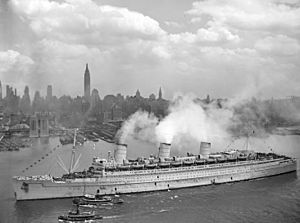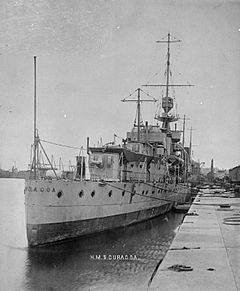HMS Curacoa (D41) facts for kids

Curacoa at anchor, 1941
|
|
Quick facts for kids History |
|
|---|---|
| Name | Curacoa |
| Namesake | Curaçao |
| Ordered | March–April 1916 |
| Builder | Pembroke Dockyard |
| Laid down | 13 July 1916 |
| Launched | 5 May 1917 |
| Commissioned | 18 February 1918 |
| Reclassified | Converted to anti-aircraft cruiser, 1939–1940 |
| Nickname(s) | Cocoa Boat |
| Fate | Sunk in collision with RMS Queen Mary, 2 October 1942 |
| General characteristics (as built) | |
| Class and type | C-class light cruiser |
| Displacement | 4,190 long tons (4,260 t) |
| Length | 450 ft 3 in (137.2 m) (o/a) |
| Beam | 43 ft 5 in (13.2 m) |
| Draught | 14 ft 8 in (4.5 m) (mean) |
| Installed power |
|
| Propulsion | 2 × shafts; 2 × geared steam turbines |
| Speed | 29 kn (54 km/h; 33 mph) |
| Complement | 460 |
| Armament |
|
| Armour |
|
| General characteristics (where different) | |
| Type | Anti-aircraft cruiser |
| Displacement | 5,403 long tons (5,490 t) (deep load) |
| Armament |
|
HMS Curacoa was a light cruiser built for the Royal Navy during World War I. She was part of the Ceres class of ships. Curacoa often served as a flagship, meaning she carried the admiral's flag.
She joined the Harwich Force during World War I but saw little fighting. This was because she was finished less than a year before the war ended. In 1919, Curacoa went to the Baltic Sea to help fight against the Bolsheviks during the Russian Civil War. While there, she hit a naval mine and had to go home for repairs.
After being in reserve for a while, she rejoined the Atlantic Fleet until 1928. She also spent some time in the Mediterranean Fleet in 1922–1923. This was to support British interests in Turkey during the Chanak Crisis.
In 1933, Curacoa became a training ship. In July 1939, just before World War II began, she was changed into an anti-aircraft cruiser. She started service again in January 1940. During the Norwegian Campaign that April, German aircraft damaged her. After repairs, she spent two years protecting convoys around the British Isles. In 1942, while on escort duty, she was accidentally cut in half and sunk by the large ocean liner RMS Queen Mary. Sadly, 337 men were lost.
Contents
Ship Design and Features
The C-class cruisers were made to protect the main fleet. They also defended against enemy destroyers trying to get close enough to fire torpedos. The Ceres sub-class was a bit bigger and better than the earlier Caledon sub-class.
Curacoa was about 450 feet 3 inches (137.2 m) long. She was 43 feet 5 inches (13.2 m) wide and sat about 14 feet 8 inches (4.5 m) deep in the water. Her weight, or displacement, was 4,190 long tons (4,260 t) when fully loaded.
The ship was powered by two steam turbines. These turbines used steam from six Yarrow boilers. This system gave her a top speed of about 29 knots (54 km/h; 33 mph). During her tests in 1918, Curacoa reached her planned speed. She could carry 935 long tons (950 t) of fuel oil. The ship had a crew of about 460 sailors.
The main weapons on the Ceres-class ships were five 6-inch (152 mm) guns. These guns were placed along the center of the ship. Two 3-inch (76 mm) anti-aircraft (AA) guns were placed near the front funnel. The ships also had eight 21-inch (533 mm) torpedo tubes in four twin mounts, two on each side.
The Ceres class had armor along its waterline that was 1.5–3 in (38–76 mm) thick. The deck over the steering area had 1 in (25 mm) thick armor. Unlike her sister ships, Curacoa's conning tower (a protected control room) was removed before she was finished.
Building and Service History
Curacoa was ordered in 1916. She was the fourth Royal Navy ship to have this name. The name honored the capture of the Dutch island of Curaçao in 1807. The ship was laid down (construction started) at Pembroke Royal Dockyard on 13 July 1916. She was launched on 5 May 1917 and finished on 18 February 1918.
Her first commander was Captain Barry Domvile. When she was ready, Curacoa became the flagship of the 5th Light Cruiser Squadron. This squadron was part of the Harwich Force. On 26 February, King George V inspected her crew at Harwich Dockyard. From June 1918, she took part in scouting missions. Around this time, two 2-pounder (40 mm) "pom-pom" anti-aircraft guns were added.
In April 1919, Curacoa joined the 1st Light Cruiser Squadron of the new Atlantic Fleet. The next month, she went to the Baltic Sea. This was part of the British effort to help the White Russians fight against the Bolsheviks in the Russian Civil War.
On 7 May, Rear-Admiral Walter Cowan moved his flag to Curacoa. Ten days later, the ship hit a mine near Reval (now Tallinn). One sailor died and three were hurt. Curacoa could still move at 9 knots (17 km/h; 10 mph) after some quick repairs. She returned to the UK for full repairs at Sheerness Dockyard. Her rudder fell off on the way, and she had to be steered using her engines for the last 500 miles (800 km).
After repairs, Curacoa was put into reserve. She stayed there until November 1920. Later, she became the flagship of the 2nd Light Cruiser Squadron of the Atlantic Fleet until 1928. In September 1922, she went to the Mediterranean Fleet during the Chanak Crisis. She arrived in Smyrna (now Izmir), Turkey, on 23 September. Her crew helped people leave the city after a big fire destroyed much of it. Curacoa stayed in the Mediterranean until at least February 1923. In the mid-1920s, her old rangefinders were replaced with larger ones.
On 4 September 1929, the ship moved to the Mediterranean Fleet. She became the flagship of the 3rd Cruiser Squadron. Her first captain, Barry Domvile, was now in charge of this squadron. She stayed in the Mediterranean until 1932.
On 18 December 1933, she became a gunnery training ship. She kept this role until 1939. In 1935, Curacoa was in the British film Brown on Resolution. In the movie, she played a German battlecruiser.
In July 1939, just before World War II, she began to be changed into an anti-aircraft cruiser at Chatham Dockyard. This meant replacing all her 6-inch guns with eight 4-inch (102 mm) dual-purpose guns. These new guns could fire at both ships and aircraft. A special four-gun mount for the 2-pounder "pom-pom" anti-aircraft gun was added. Machine guns were also added, and her torpedo tubes were removed. Her masts were made shorter. New fire-control radar systems and an early-warning radar were installed. To balance the ship, 200 long tons (203 t) of ballast (heavy material) was added.
World War II Service
The changes were finished on 24 January 1940. Curacoa then joined the Home Fleet. During the Norwegian Campaign, she protected a British troop convoy going to Åndalsnes in April. With another cruiser, Arethusa, Curacoa landed soldiers at Molde. The quay at Åndalsnes was too small for more than one cruiser at a time.
Curacoa returned home but was sent back to Åndalsnes. Her job was to protect the beachhead (landing area) from German aircraft. She arrived on 22 April. Over the next few days, she was attacked many times. On the evening of 24 April, a German bomber hit her forecastle (front part of the ship) with a 250-kilogram (550 lb) bomb. Eight crew members died. They were buried at Veblungsnes after the ship returned home for repairs.
After her repairs, Curacoa was sent to the Western Approaches. For most of the next two years, she protected convoys around the British Isles. By September 1941, new radar systems were added. In June 1942, she was part of a fake convoy to trick the Germans during Convoy PQ 17. By September 1942, she had more anti-aircraft guns, including five 20 mm Oerlikon guns. A long-range surface-search radar was also added.
The Collision

On the morning of 2 October 1942, Curacoa met the ocean liner Queen Mary north of Ireland. The Queen Mary was carrying about 10,000 American soldiers. The liner was sailing in a special "Zig-Zag Pattern" to avoid U-boat attacks. She was moving at 28.5 knots (52.8 km/h; 32.8 mph). The older cruiser stayed on a straight path at 25 knots (46 km/h; 29 mph), and the liner would eventually catch up to her.
Both captains understood the "Rule of the Road" differently. Each believed his ship had the right of way. Captain John Wilfred Boutwood of Curacoa kept his ship on a straight course. He thought this would best protect the liner from enemy aircraft. Commodore Sir Cyril Gordon Illingworth of Queen Mary continued his zig-zag pattern. He expected the escort cruiser to move out of his way.
At 1:32 PM, during a zig-zag turn, it became clear that Queen Mary would get too close to the cruiser. The liner's officer of the watch tried to stop the turn. But Illingworth told him to: "Carry on with the zig-zag. These chaps are used to escorting; they will keep out of your way and won't interfere with you."
At 2:04 PM, Queen Mary began a turn from slightly behind Curacoa, about 400 yards (366 m) away. Captain Boutwood saw the danger. But the ships were too close, and moving too fast, for any quick turns to make a difference. Queen Mary hit Curacoa in the middle at full speed, cutting the cruiser in half. The back part of the ship sank almost right away. The front part stayed on the surface for a few more minutes.
The Queen Mary had orders not to stop because of the risk of U-boat attacks. She continued sailing with a damaged bow. She radioed the other destroyers of her escort, about 7 nautical miles (13 km; 8.1 mi) away, to report the crash. Hours later, two escort ships returned. They rescued about 101 survivors, including Captain Boutwood. Sadly, 337 officers and men from Curacoa were lost. Most of the lost men are remembered at the Chatham Naval Memorial and the Portsmouth Naval Memorial.
Those who saw the collision were told to keep it a secret because of national security. The loss was not made public until after the war ended. The Admiralty (the British Navy's command) sued Queen Mary's owners, Cunard White Star Line, in 1943. The case went to court in 1945. In 1947, the judge said Queen Marys crew and owners were not to blame. He put all the blame on Curacoas officers. The Admiralty appealed this decision. The Court of Appeal changed the ruling. They said the Admiralty was two-thirds to blame, and Cunard White Star was one-third to blame. Cunard White Star appealed to the House of Lords, but the decision was upheld.
See also
 In Spanish: HMS Curacoa (D41) para niños
In Spanish: HMS Curacoa (D41) para niños



